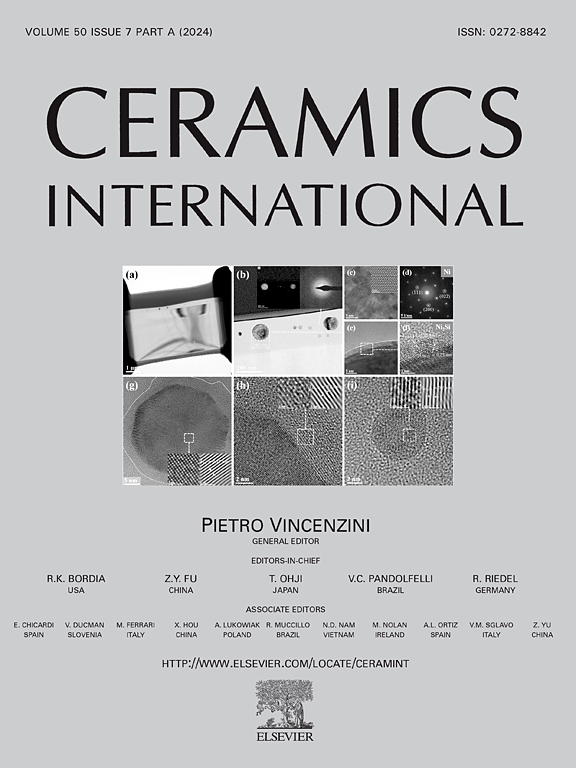在Sr2MgSi2O7:Eu2+,Dy3+表面多孔SiO2内原位合成CsPbBr3量子点获得多色余辉
IF 5.6
2区 材料科学
Q1 MATERIALS SCIENCE, CERAMICS
引用次数: 0
摘要
为了拓宽长余辉材料的应用领域,实现长余辉材料的高稳定性和多色性是一个挑战。光转换方法是使余辉同时变色的条件,但稳定高效的光转换剂是一个迫切需要解决的问题。本研究提出了在Sr2MgSi2O7:Eu2+,Dy3+ (SMS)表面的多孔SiO2内直接合成CsPbBr3量子点(QDs)的策略。所得复合材料的发光和余辉颜色由蓝色(约468 nm)向绿色(约520 nm)转变,在紫外线照射8天后,发光强度几乎不受影响,在空气照射3个月后,发光强度仍能保持在初始值的80%以上。由于合成的复合材料为粉末状,可与各种介质混合。复合材料可与涂料均匀混合,形成具有多种发光颜色的涂料,并产生有效的多色发光,在发光涂料和防伪领域具有重大潜力。本文章由计算机程序翻译,如有差异,请以英文原文为准。
Multicolor afterglow obtained by in situ synthesis of CsPbBr3 quantum dots within porous SiO2 on the surface of Sr2MgSi2O7:Eu2+,Dy3+
In order to broaden the application field of long afterglow materials, it is a challenge to realize high stability and multicolor properties of long afterglow materials. The photoconversion method is a condition that enables simultaneous afterglow color shifts, however, the stable and efficient photoconversion agent is an urgent problem. This study propose a strategy to synthesize CsPbBr3 quantum dots (QDs) directly within porous SiO2 on the surface of Sr2MgSi2O7:Eu2+,Dy3+ (SMS). The resulting composites achieve a shift in emission and afterglow color from blue (about 468 nm) to green (about 520 nm), and in the UV irradiation for 8 days, the luminous intensity is almost unaffected, in the air exposure for 3 months, the luminous intensity can still be maintained at more than 80 % of the initial value. Since the synthesized composite material is a powder, it can be mixed with various media. Composite materials can be homogeneously mixed with coatings, resulting in coatings with a variety of luminescent colors and producing effective multicolor luminescence, which has significant potential in the field of luminescent coatings and anti-counterfeiting.
求助全文
通过发布文献求助,成功后即可免费获取论文全文。
去求助
来源期刊

Ceramics International
工程技术-材料科学:硅酸盐
CiteScore
9.40
自引率
15.40%
发文量
4558
审稿时长
25 days
期刊介绍:
Ceramics International covers the science of advanced ceramic materials. The journal encourages contributions that demonstrate how an understanding of the basic chemical and physical phenomena may direct materials design and stimulate ideas for new or improved processing techniques, in order to obtain materials with desired structural features and properties.
Ceramics International covers oxide and non-oxide ceramics, functional glasses, glass ceramics, amorphous inorganic non-metallic materials (and their combinations with metal and organic materials), in the form of particulates, dense or porous bodies, thin/thick films and laminated, graded and composite structures. Process related topics such as ceramic-ceramic joints or joining ceramics with dissimilar materials, as well as surface finishing and conditioning are also covered. Besides traditional processing techniques, manufacturing routes of interest include innovative procedures benefiting from externally applied stresses, electromagnetic fields and energetic beams, as well as top-down and self-assembly nanotechnology approaches. In addition, the journal welcomes submissions on bio-inspired and bio-enabled materials designs, experimentally validated multi scale modelling and simulation for materials design, and the use of the most advanced chemical and physical characterization techniques of structure, properties and behaviour.
Technologically relevant low-dimensional systems are a particular focus of Ceramics International. These include 0, 1 and 2-D nanomaterials (also covering CNTs, graphene and related materials, and diamond-like carbons), their nanocomposites, as well as nano-hybrids and hierarchical multifunctional nanostructures that might integrate molecular, biological and electronic components.
 求助内容:
求助内容: 应助结果提醒方式:
应助结果提醒方式:


